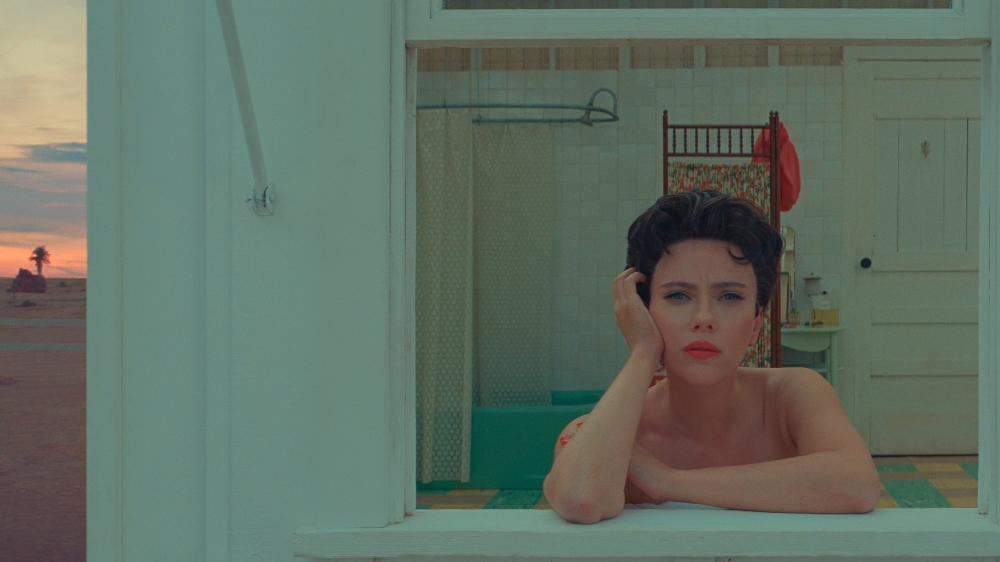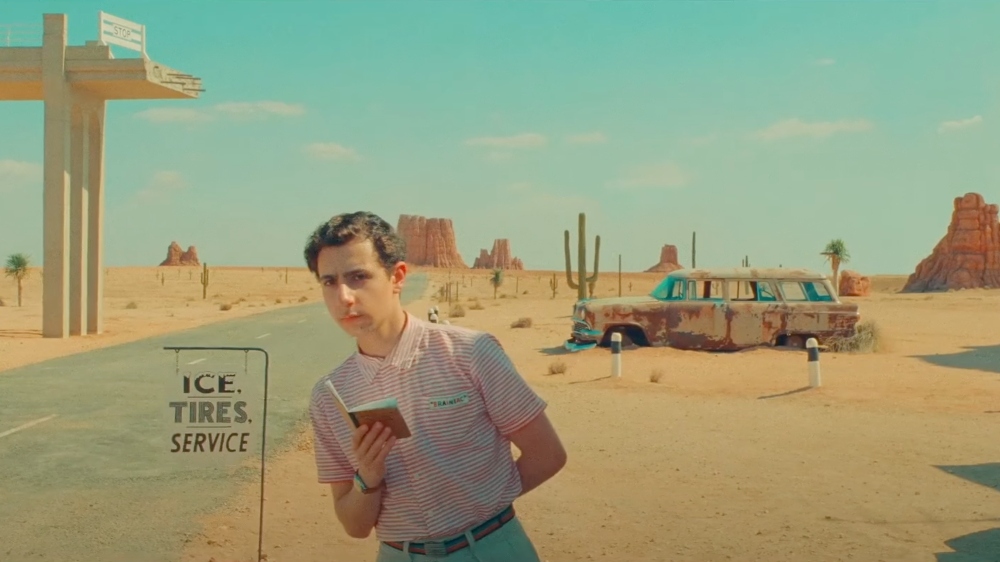To say that Asteroid City evokes the sensation of discovering Wes Anderson‘s films for the first time is to say that there are few filmmakers so immediately distinctive — at this point an obvious statement to make. After all, Anderson’s idiosyncrasies as an artist have long been his most familiar attribute, and his visual eccentricities and undercurrents of rich emotionality central to his astonishingly mainstream appeal.
With his 11th feature, however, a nervous thrill of discovery is indeed both palpable and paramount to the plot. Set in the American Southwest, circa 1955, the film opens in transit as a freight train barrels through a brightly saturated desert landscape and toward a modest outpost (population: 87), home to a meteor crater and a celestial observatory, where a few inquisitively minded children and their parents will soon gather for a Junior Stargazer competition.
Augie Steenbeck (Jason Schwartzman) is one such parent, chaperoning his talented teenage son Woodrow (Jake Ryan, Eighth Grade) along with three daughters in their wood-sided Mercury Monterey. Once the car breaks down on their way into town, Augie realizes they might be stranded in Asteroid City a while longer, perhaps a fated stop-over given the significance of the news he has to relay to his children — their ailing mother has died. After meeting a motel manager (Steve Carell) with a green sunshade, Augie checks his family into one cabin, soon discovering that famous actress Midge Campbell (Scarlett Johansson), in town with her science-prodigy daughter (Grace Edward), is in the cabin next door. Gradually, they start talking through the window.
Elsewhere, far away from the desert, on a black-and-white studio set, a company of New York stage actors is preparing a play called Asteroid City. As a narrator (Bryan Cranston) informs us, however, it will never be performed. Instead, what we’re seeing is a teleplay about its production, making Anderson’s film another one of the nesting-doll contraptions he has recently favored. For playwright Conrad Earp (Edward Norton) and his leading actors, Jones Hall (Schwartzman) and Mercedes Ford (Johansson), faithfully depicting the events that are soon to derail the Junior Stargazer competition is of utmost importance.

This structure sets up Asteroid City as a film that explores the distance between truth and representation, between reality and performance, in Anderson’s typically mannered yet emotionally profound style. But once the Stargazers are assembled and the arrival of an even more unexpected visitor from out of town brings the government to Asteroid City as well, Anderson finds an even richer, philosophical vein to explore surrounding the role that faith plays in the creation of life and the acceptance of death, and how we navigate our place in an uncertain universe and make peace with the limits of our understanding.
Throughout, Anderson moves steadily back and forth between the frontier and the theater, shifting between aspect ratios and from color to black-and-white as he does so; these diametrically opposed poles of intrigue allow Asteroid City to extravagantly detail two mythical American settings and draw surprising connections between them. In this film, everyone’s watching the skies, which Anderson renders in baby-blue hues that complement the sun-scorched, red-rock terrain, and the question of what they see there is a central one, especially as the framing device of the film reminds us that we are watching actors playing actors playing actors.
Anderson’s vivid color scheme, as always, eschews realism to instead suggest another colorful diorama of symmetrical precision and precisely framed melodrama. A roadrunner meep-meeping through adds to the sense of this Looney Tunes desert, imaginary and apocryphal, or a replica of a set where Westerns once shot. A 12-stool luncheonette, a one-pump filling station, a 10-cabin motor-court hotel, and a telephone booth fill out the town’s other major attractions, each rendered in Anderson’s signature pastel palette.
Considering Asteroid City within Anderson’s oeuvre only deepens the experience of watching it. A Houston-bred filmmaker whose early work conveyed American attitudes in both setting and theme, from the ivy-covered prep-school pantomime of Rushmore to the cheerfully provincial crime caper of Bottle Rocket, Anderson’s work has grown more cosmopolitan over the years — the artificiality of its box-like framing more playfully exaggerated. The Life Aquatic set sail for fictional seas where its characters could hunt for white whales both literal and imagined, while The Darjeeling Limited followed tourist brothers across India while satirizing their self-conception as strangers in a strange land.
With The Grand Budapest Hotel, excavating the forgotten past of a mythical European nation while distilling its alluring exoticism as a refuge of Hollywood fantasy, Anderson’s flamboyant artifice reached new heights even as its human element accrued melancholic depth and, in it, an aristocratic elegance. Far from peddling in empty escapism, Grand Budapest established Anderson’s travels abroad as holistically cinematic progression, its highbrow international flavor offering him freedom to extend his meticulously detailed mise-en-scene and the emotional architecture of its nested framework displaying the filmmaker’s delightfully renewed sense of confidence.

His next live-action film, The French Dispatch, structured to evoke the feeling of flipping through an issue of The New Yorker, told stories within stories that revealed as much about their writers as their subjects. Intricately self-reflexive throughout its omnibus-style recollection of experience, the film indicated Anderson’s own views on authorship as a process of creating entire worlds imbued with one’s own self-image, reflective mainly of an author’s personal vantage point rather than any kind of objective view. Grand Budapest, as with all Anderson’s films, found him examining the emotional interplay between past and present; indeed, the stories Anderson tells, and the worlds they unfurl, exist in a confluence of memory and imagination where his obsessive style illuminates and deepens their yearning, nostalgic substance.
Asteroid City brings these driving concepts of Anderson’s filmography together in ways surprising and delightful. Even as the film finds him returning to American locales, this is a film that longs for a bygone type of national imagination, a belief in storytelling as the most important avenue to emotional reality and profound revelation. Simultaneously, it feels like an expansion of his most meaningful creative collaborations; right from the first few minutes, the film is dynamically shot by Anderson’s cinematographer Robert Yeoman, and its script (co-credited to frequent collaborator Roman Coppola) is a treasure trove of quirky Andersonian wisdoms and insights reflecting on the nuclear paranoia that lingers at the edge of town and the difficulty that the actors face in capturing this strange period of history — when scientific discovery was at once at the forefront of the imagination and freighted with an unshakeable sense of dread and uncertainty.
Anderson’s way with actors and his skill with directing swelling ensembles to the same style of detached, deadpan expression, reaches a creative apogee of sorts in Asteroid City as well. Schwartzman commands the main role here, laying bare Augie’s grief and struggle to reconceptualize himself in relationship to it even as he also conveys the curiosity of the actor portraying this bereaved husband. Johansson, similarly, hasn’t been this captivating in years, at once channeling movie-star mystique and conveying the poignant and resigned loneliness of the woman sustaining that illusion.
Through these characters, and the intimate bond that they forge in the film’s simulacra of a small-town close encounter, Asteroid City builds in poignancy until its third act, which strides boldly into the unknown in more ways than one, leads the film to ascend into one of Anderson’s most affecting and perhaps emotionally honest films to date. In helping us process the strange and often painful course of our lives, in allowing us to understand what we can and accept what we cannot, performance and artifice let us wear masks to tell the truth, as direct a summation of Anderson’s career interests as any he’s proposed. The pleasure of this film’s surface delights, its many layers of swooning romance and bravura craftsmanship, is one with the existential poetry of its substance. It’s one of Anderson’s most mature and fully formed artistic statements to date.
Grade: A
Focus Features will release Asteroid City in select theaters on Friday, June 16.



